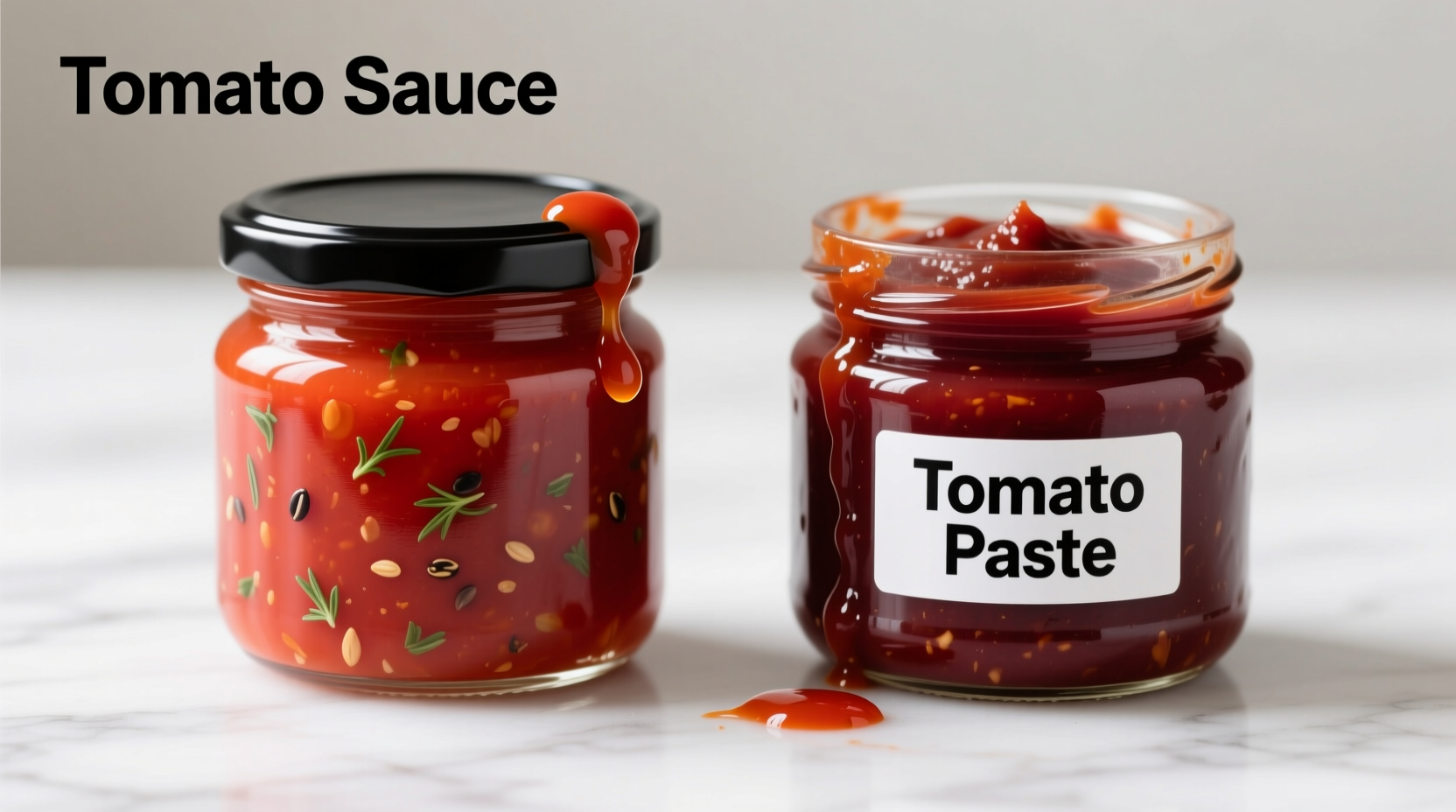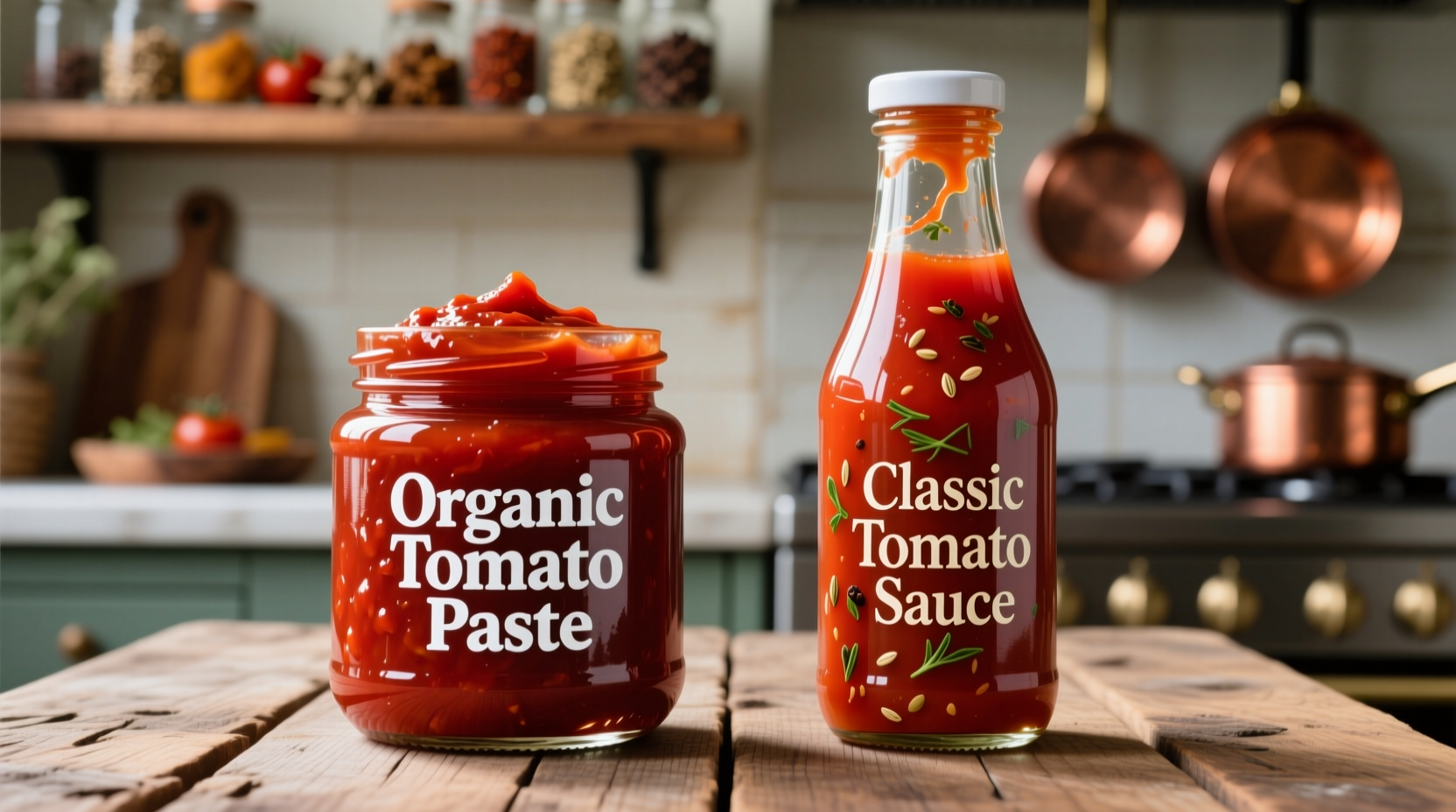Why Confusing Sauce and Paste Ruins Your Dishes (And How to Fix It)
Ever wondered why your pasta sauce turned out too thin or your stew tasted unexpectedly sweet? The culprit is often misusing tomato sauce and tomato paste. These pantry staples serve completely different purposes in cooking, despite coming from the same ingredient. Let's break down exactly when and how to use each one correctly.
Core Differences at a Glance
Before diving into cooking applications, let's establish the fundamental distinctions between these two tomato products. Many home cooks treat them interchangeably, but professional chefs know they're designed for specific culinary roles.
| Characteristic | Tomato Sauce | Tomato Paste |
|---|---|---|
| Tomato Solids Content | 24-30% | 24-36% (concentrated) |
| Consistency | Thin, pourable liquid | Thick, almost solid paste |
| Seasoning | Typically includes herbs, salt, sugar | Plain, unseasoned |
| Primary Culinary Role | Ready-to-use component | Flavor foundation/base |
| Preparation Needed | None (ready to use) | Requires dilution or cooking |
When to Reach for Tomato Sauce
Tomato sauce works as a convenient building block in recipes where you want immediate flavor without additional preparation. According to the USDA FoodData Central database, commercial tomato sauce typically contains about 45 calories per 100g with added seasonings that vary by brand.
Ideal applications:
- Pasta dishes - Ready to heat and serve with your favorite noodles
- Quick soups - Forms the base for minestrone or tomato soup
- Casseroles - Provides moisture and flavor without additional liquid
- Everyday cooking - When you need a time-saving option
Professional chefs at the Culinary Institute of America note that tomato sauce's pre-seasoned nature makes it perfect for weeknight cooking but less versatile for creating custom flavor profiles.
When Tomato Paste Shines
Tomato paste represents the concentrated essence of tomatoes, with water removed through cooking. The Food and Agriculture Organization (FAO) documents that traditional tomato paste production involves slow reduction over several hours to develop deep umami flavors.
Best uses for tomato paste:
- Flavor foundation - Sautéed with aromatics to build depth in sauces
- Thickening agent - Adds body without excess liquid
- Color enhancement - Deepens the red hue in stews and braises
- Umami booster - Adds savory complexity to meat dishes
Here's a professional chef technique: "Always cook tomato paste in oil for 2-3 minutes until it darkens slightly," recommends Antonio Rodriguez. "This caramelization process unlocks deeper flavors that raw paste can't provide."

Substituting Between Sauce and Paste
Running out of one ingredient doesn't have to ruin your meal. Understanding the proper conversion ratios saves your recipe:
- Paste to sauce: Mix 1 part paste with 2 parts water (or broth)
- Sauce to paste: Simmer sauce uncovered until reduced by 60-70%
Important note: When substituting, adjust seasonings accordingly. Commercial tomato sauce often contains added sugar and salt that paste lacks. The American Heart Association recommends checking sodium content when making substitutions for health-conscious cooking.
Storage Guidelines That Preserve Quality
Proper storage extends the shelf life of both products while maintaining flavor integrity:
- Unopened cans: Store in cool, dry place for 12-18 months
- Opened tomato sauce: Refrigerate in airtight container for 5-7 days
- Opened tomato paste: Freeze in tablespoon portions for up to 6 months
Food safety experts at the National Center for Home Food Preservation confirm that freezing tomato paste in ice cube trays then transferring to freezer bags maintains quality better than leaving it in opened cans.
Avoid These Common Mistakes
Even experienced cooks sometimes misuse these ingredients. Watch out for these pitfalls:
- Using paste directly in cold dishes - Creates unpleasant texture and overly intense flavor
- Adding sauce to reduce liquid - Dilutes flavor instead of concentrating it
- Not adjusting seasonings when substituting - Leads to overly salty or sweet results
- Storing opened paste in the can - Causes metallic taste and faster spoilage
When Regional Cuisine Matters
Culinary traditions influence how these products are used. Italian cooking typically employs tomato paste as a flavor foundation (soffritto), while American-style recipes often use ready-made tomato sauce for convenience. The evolution of these products reflects changing cooking habits - tomato paste became popular in commercial kitchens in the 1920s for its shelf stability, while pre-seasoned tomato sauce gained popularity with the rise of convenience cooking in the 1950s.
Practical Application Guide
Follow this decision tree for perfect results every time:
- Is your recipe already liquid-based? (soup, stew, braise) → Use tomato paste
- Do you need immediate flavor without cooking time? → Use tomato sauce
- Are you building complex flavors from scratch? → Start with tomato paste
- Is speed your priority? → Use tomato sauce
Remember: Professional kitchens often use both products in the same dish - paste for depth at the beginning of cooking, sauce for volume and convenience later in the process.











 浙公网安备
33010002000092号
浙公网安备
33010002000092号 浙B2-20120091-4
浙B2-20120091-4